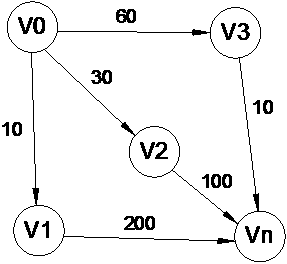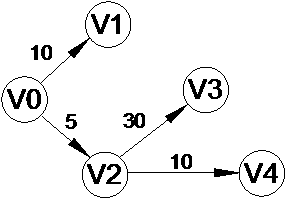Random Shortest Path Routing Method
A shortest path and routing technology, applied in digital transmission systems, data exchange networks, electrical components, etc.
- Summary
- Abstract
- Description
- Claims
- Application Information
AI Technical Summary
Problems solved by technology
Method used
Image
Examples
Embodiment 1
[0024] Embodiment 1: as figure 1 and figure 2 Shown:
[0025] With V0 as the starting point S and Vn as the destination point D, the user enters n=2, and the path is calculated and counted by the Dijikstra algorithm, and the following paths and path lengths can be obtained:
[0026] V0V1Vn=210; V0V2Vn=130; V0V3Vn=70.
[0027] Among them, the two paths V0V2Vn=130 and V0V3Vn=70 are the second shortest and the shortest respectively, so V2 and V3 are selected as the jumping points.
[0028] In summary, the determined paths are V0V2Vn and V0V3Vn, and after updating the routing table, data packets are randomly sent on these two paths.
Embodiment 2
[0029] Embodiment 2: as figure 1 and image 3 Shown:
[0030] With V0 as the starting point S and V4 as the destination point D, the user enters n=2, and the path is calculated and counted by the Dijikstra algorithm. Since the adjacent take-off points are insufficient for the required number of take-off points, n>the number of available paths k, so μ=k=1, only the only path can be obtained:
[0031] V0V2V4=15.
[0032] In summary, the determined path is V0V2V4, and the data packet is sent on this path after the routing table is updated.
Embodiment 3
[0033] Embodiment 3: as figure 1 and Figure 4 Shown:
[0034] With V0 as the starting point S and V3 as the destination point D, the user enters n=2, and the path is calculated and counted by the Dijikstra algorithm, and the following paths and path lengths can be obtained:
[0035] V0V5V4V3=180; V0V5V3=130; V0V4V3=50;
[0036] V0V6V3=25; V0V2V3=60; V0V6V2V3=65.
[0037] Among them, the two paths V0V4V3=50 and V0V6V3=25 are the second shortest and the shortest respectively, so V4 and V6 are selected as the jumping points.
[0038] Taking V4 as the starting point S and V3 as the destination point D, after calculating and counting the paths through the Dijikstra algorithm, the following paths and path lengths can be obtained:
[0039] V4V3=20; V4V7V3=15. Select V4V7V3 as the path.
[0040] Taking V6 as the starting point S and V3 as the destination point D, after calculating and counting the paths through the Dijikstra algorithm, the following paths and path lengths can b...
PUM
 Login to View More
Login to View More Abstract
Description
Claims
Application Information
 Login to View More
Login to View More - R&D
- Intellectual Property
- Life Sciences
- Materials
- Tech Scout
- Unparalleled Data Quality
- Higher Quality Content
- 60% Fewer Hallucinations
Browse by: Latest US Patents, China's latest patents, Technical Efficacy Thesaurus, Application Domain, Technology Topic, Popular Technical Reports.
© 2025 PatSnap. All rights reserved.Legal|Privacy policy|Modern Slavery Act Transparency Statement|Sitemap|About US| Contact US: help@patsnap.com



